Leadership and Management in Operations at Marks & Spencer: A Report
VerifiedAdded on 2020/11/23
|16
|4784
|81
Report
AI Summary
This report provides an in-depth analysis of leadership and management practices within Marks & Spencer (M&S). It defines and compares the roles and characteristics of leaders and managers, illustrating their functions in various situations, such as decision-making and employee engagement. The report explores the application of different leadership theories, including transformational, situational, and system leadership, within the context of M&S's operations. Furthermore, it examines key approaches to operations management, emphasizing the importance of leaders and managers in these processes, and discusses environmental factors influencing business decisions and operational strategies. The analysis covers the practical implications of these concepts, offering insights into how M&S navigates challenges and opportunities in the retail sector.
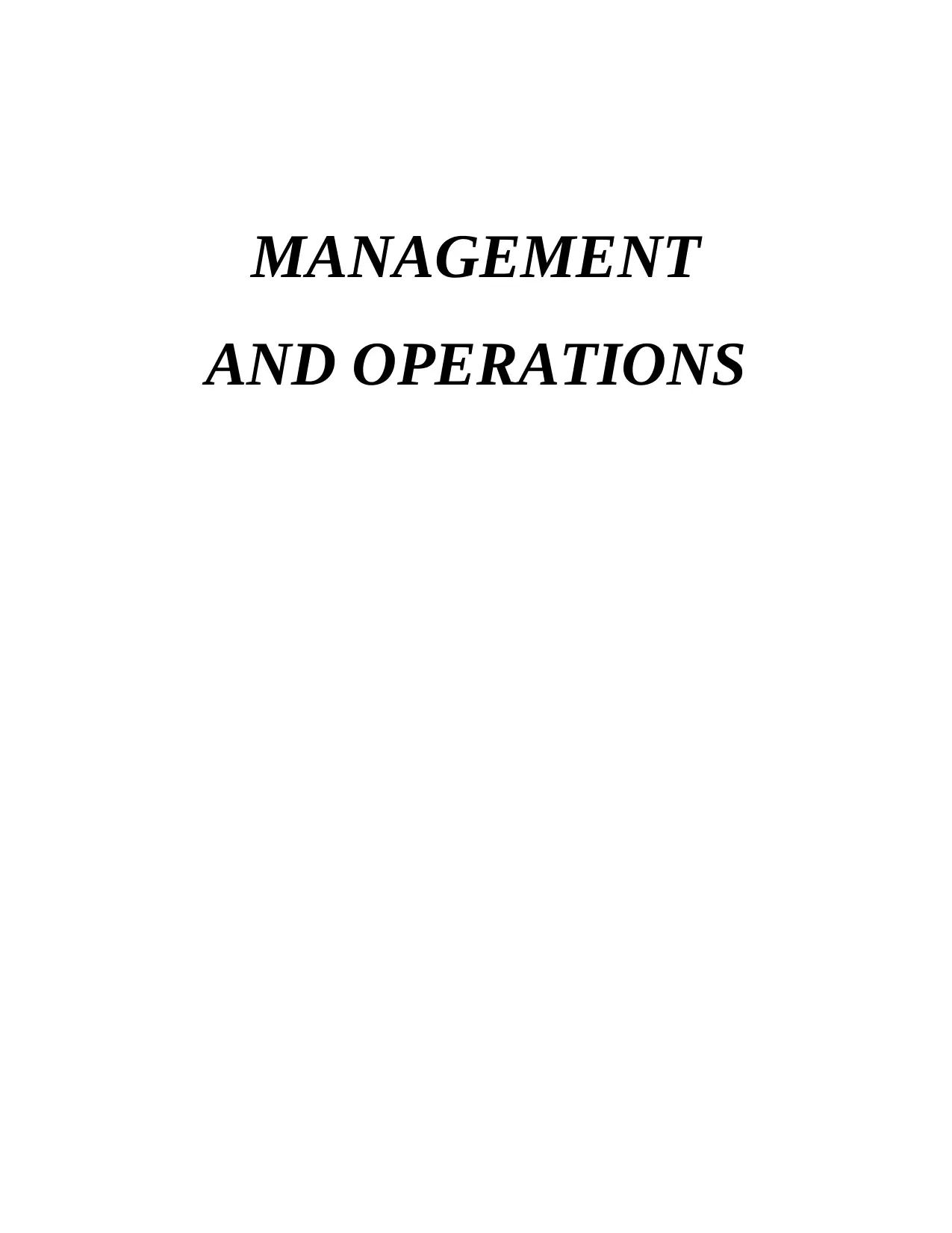
MANAGEMENT
AND OPERATIONS
AND OPERATIONS
Paraphrase This Document
Need a fresh take? Get an instant paraphrase of this document with our AI Paraphraser
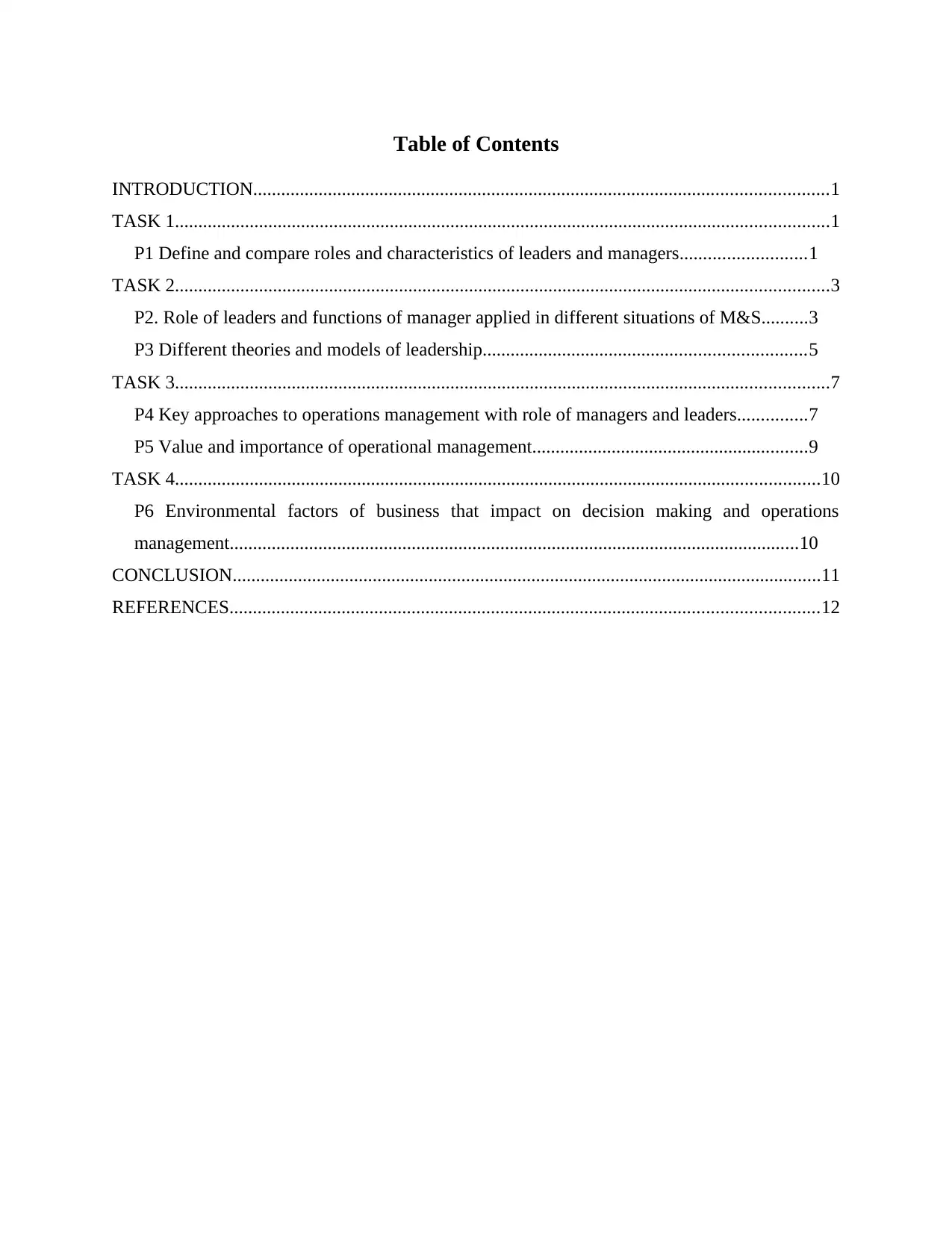
Table of Contents
INTRODUCTION...........................................................................................................................1
TASK 1............................................................................................................................................1
P1 Define and compare roles and characteristics of leaders and managers...........................1
TASK 2............................................................................................................................................3
P2. Role of leaders and functions of manager applied in different situations of M&S..........3
P3 Different theories and models of leadership.....................................................................5
TASK 3............................................................................................................................................7
P4 Key approaches to operations management with role of managers and leaders...............7
P5 Value and importance of operational management...........................................................9
TASK 4..........................................................................................................................................10
P6 Environmental factors of business that impact on decision making and operations
management..........................................................................................................................10
CONCLUSION..............................................................................................................................11
REFERENCES..............................................................................................................................12
INTRODUCTION...........................................................................................................................1
TASK 1............................................................................................................................................1
P1 Define and compare roles and characteristics of leaders and managers...........................1
TASK 2............................................................................................................................................3
P2. Role of leaders and functions of manager applied in different situations of M&S..........3
P3 Different theories and models of leadership.....................................................................5
TASK 3............................................................................................................................................7
P4 Key approaches to operations management with role of managers and leaders...............7
P5 Value and importance of operational management...........................................................9
TASK 4..........................................................................................................................................10
P6 Environmental factors of business that impact on decision making and operations
management..........................................................................................................................10
CONCLUSION..............................................................................................................................11
REFERENCES..............................................................................................................................12

⊘ This is a preview!⊘
Do you want full access?
Subscribe today to unlock all pages.

Trusted by 1+ million students worldwide
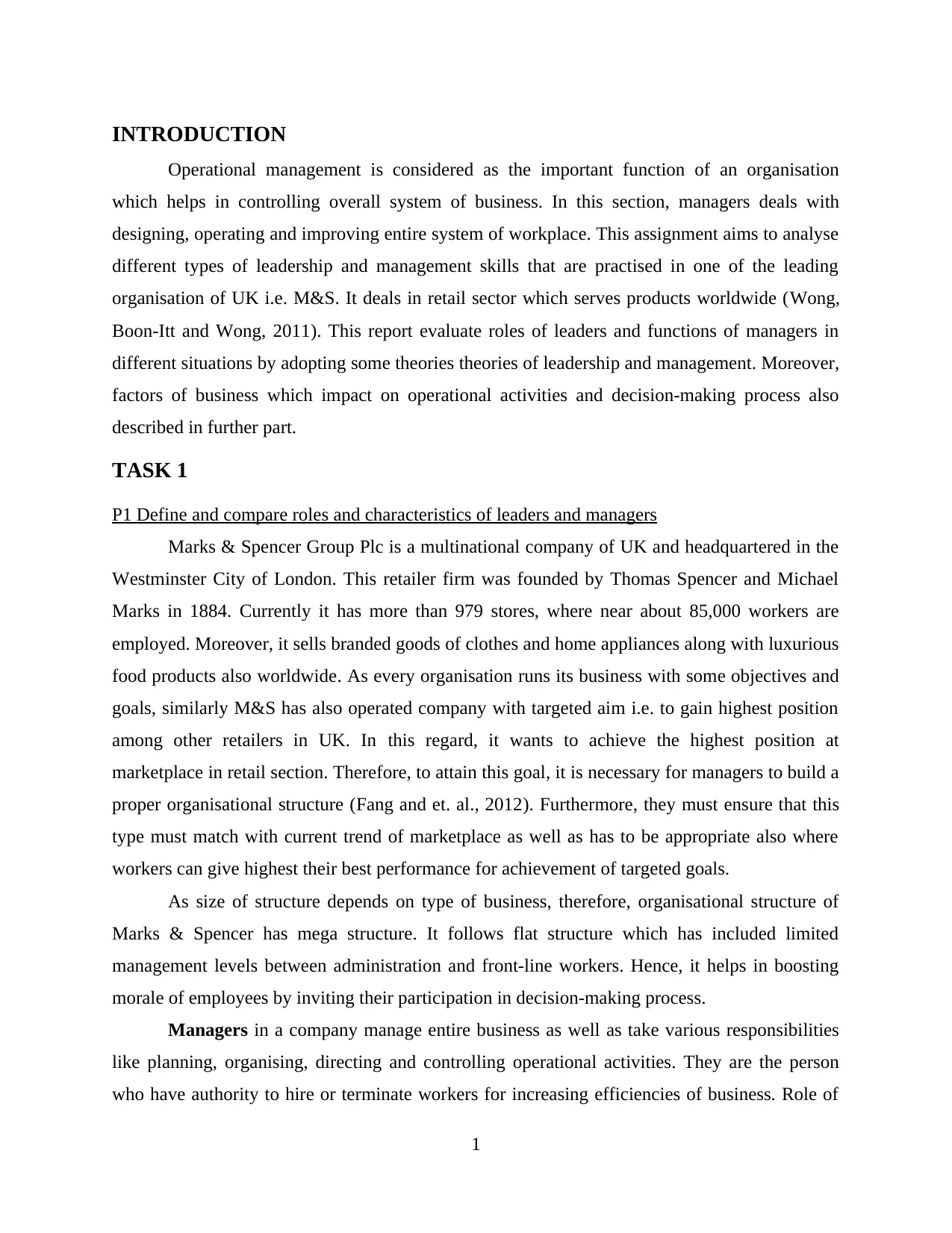
INTRODUCTION
Operational management is considered as the important function of an organisation
which helps in controlling overall system of business. In this section, managers deals with
designing, operating and improving entire system of workplace. This assignment aims to analyse
different types of leadership and management skills that are practised in one of the leading
organisation of UK i.e. M&S. It deals in retail sector which serves products worldwide (Wong,
Boon-Itt and Wong, 2011). This report evaluate roles of leaders and functions of managers in
different situations by adopting some theories theories of leadership and management. Moreover,
factors of business which impact on operational activities and decision-making process also
described in further part.
TASK 1
P1 Define and compare roles and characteristics of leaders and managers
Marks & Spencer Group Plc is a multinational company of UK and headquartered in the
Westminster City of London. This retailer firm was founded by Thomas Spencer and Michael
Marks in 1884. Currently it has more than 979 stores, where near about 85,000 workers are
employed. Moreover, it sells branded goods of clothes and home appliances along with luxurious
food products also worldwide. As every organisation runs its business with some objectives and
goals, similarly M&S has also operated company with targeted aim i.e. to gain highest position
among other retailers in UK. In this regard, it wants to achieve the highest position at
marketplace in retail section. Therefore, to attain this goal, it is necessary for managers to build a
proper organisational structure (Fang and et. al., 2012). Furthermore, they must ensure that this
type must match with current trend of marketplace as well as has to be appropriate also where
workers can give highest their best performance for achievement of targeted goals.
As size of structure depends on type of business, therefore, organisational structure of
Marks & Spencer has mega structure. It follows flat structure which has included limited
management levels between administration and front-line workers. Hence, it helps in boosting
morale of employees by inviting their participation in decision-making process.
Managers in a company manage entire business as well as take various responsibilities
like planning, organising, directing and controlling operational activities. They are the person
who have authority to hire or terminate workers for increasing efficiencies of business. Role of
1
Operational management is considered as the important function of an organisation
which helps in controlling overall system of business. In this section, managers deals with
designing, operating and improving entire system of workplace. This assignment aims to analyse
different types of leadership and management skills that are practised in one of the leading
organisation of UK i.e. M&S. It deals in retail sector which serves products worldwide (Wong,
Boon-Itt and Wong, 2011). This report evaluate roles of leaders and functions of managers in
different situations by adopting some theories theories of leadership and management. Moreover,
factors of business which impact on operational activities and decision-making process also
described in further part.
TASK 1
P1 Define and compare roles and characteristics of leaders and managers
Marks & Spencer Group Plc is a multinational company of UK and headquartered in the
Westminster City of London. This retailer firm was founded by Thomas Spencer and Michael
Marks in 1884. Currently it has more than 979 stores, where near about 85,000 workers are
employed. Moreover, it sells branded goods of clothes and home appliances along with luxurious
food products also worldwide. As every organisation runs its business with some objectives and
goals, similarly M&S has also operated company with targeted aim i.e. to gain highest position
among other retailers in UK. In this regard, it wants to achieve the highest position at
marketplace in retail section. Therefore, to attain this goal, it is necessary for managers to build a
proper organisational structure (Fang and et. al., 2012). Furthermore, they must ensure that this
type must match with current trend of marketplace as well as has to be appropriate also where
workers can give highest their best performance for achievement of targeted goals.
As size of structure depends on type of business, therefore, organisational structure of
Marks & Spencer has mega structure. It follows flat structure which has included limited
management levels between administration and front-line workers. Hence, it helps in boosting
morale of employees by inviting their participation in decision-making process.
Managers in a company manage entire business as well as take various responsibilities
like planning, organising, directing and controlling operational activities. They are the person
who have authority to hire or terminate workers for increasing efficiencies of business. Role of
1
Paraphrase This Document
Need a fresh take? Get an instant paraphrase of this document with our AI Paraphraser
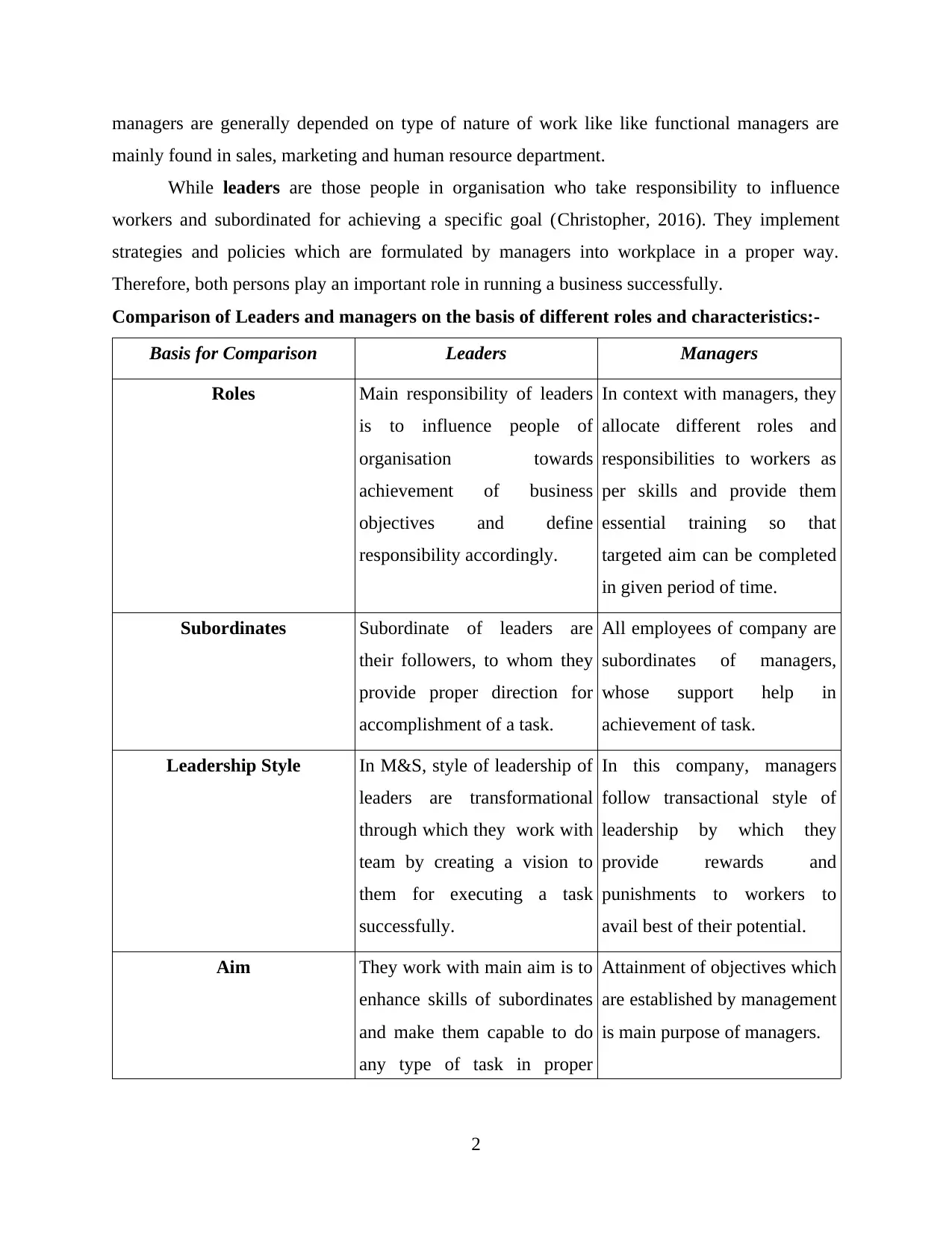
managers are generally depended on type of nature of work like like functional managers are
mainly found in sales, marketing and human resource department.
While leaders are those people in organisation who take responsibility to influence
workers and subordinated for achieving a specific goal (Christopher, 2016). They implement
strategies and policies which are formulated by managers into workplace in a proper way.
Therefore, both persons play an important role in running a business successfully.
Comparison of Leaders and managers on the basis of different roles and characteristics:-
Basis for Comparison Leaders Managers
Roles Main responsibility of leaders
is to influence people of
organisation towards
achievement of business
objectives and define
responsibility accordingly.
In context with managers, they
allocate different roles and
responsibilities to workers as
per skills and provide them
essential training so that
targeted aim can be completed
in given period of time.
Subordinates Subordinate of leaders are
their followers, to whom they
provide proper direction for
accomplishment of a task.
All employees of company are
subordinates of managers,
whose support help in
achievement of task.
Leadership Style In M&S, style of leadership of
leaders are transformational
through which they work with
team by creating a vision to
them for executing a task
successfully.
In this company, managers
follow transactional style of
leadership by which they
provide rewards and
punishments to workers to
avail best of their potential.
Aim They work with main aim is to
enhance skills of subordinates
and make them capable to do
any type of task in proper
Attainment of objectives which
are established by management
is main purpose of managers.
2
mainly found in sales, marketing and human resource department.
While leaders are those people in organisation who take responsibility to influence
workers and subordinated for achieving a specific goal (Christopher, 2016). They implement
strategies and policies which are formulated by managers into workplace in a proper way.
Therefore, both persons play an important role in running a business successfully.
Comparison of Leaders and managers on the basis of different roles and characteristics:-
Basis for Comparison Leaders Managers
Roles Main responsibility of leaders
is to influence people of
organisation towards
achievement of business
objectives and define
responsibility accordingly.
In context with managers, they
allocate different roles and
responsibilities to workers as
per skills and provide them
essential training so that
targeted aim can be completed
in given period of time.
Subordinates Subordinate of leaders are
their followers, to whom they
provide proper direction for
accomplishment of a task.
All employees of company are
subordinates of managers,
whose support help in
achievement of task.
Leadership Style In M&S, style of leadership of
leaders are transformational
through which they work with
team by creating a vision to
them for executing a task
successfully.
In this company, managers
follow transactional style of
leadership by which they
provide rewards and
punishments to workers to
avail best of their potential.
Aim They work with main aim is to
enhance skills of subordinates
and make them capable to do
any type of task in proper
Attainment of objectives which
are established by management
is main purpose of managers.
2
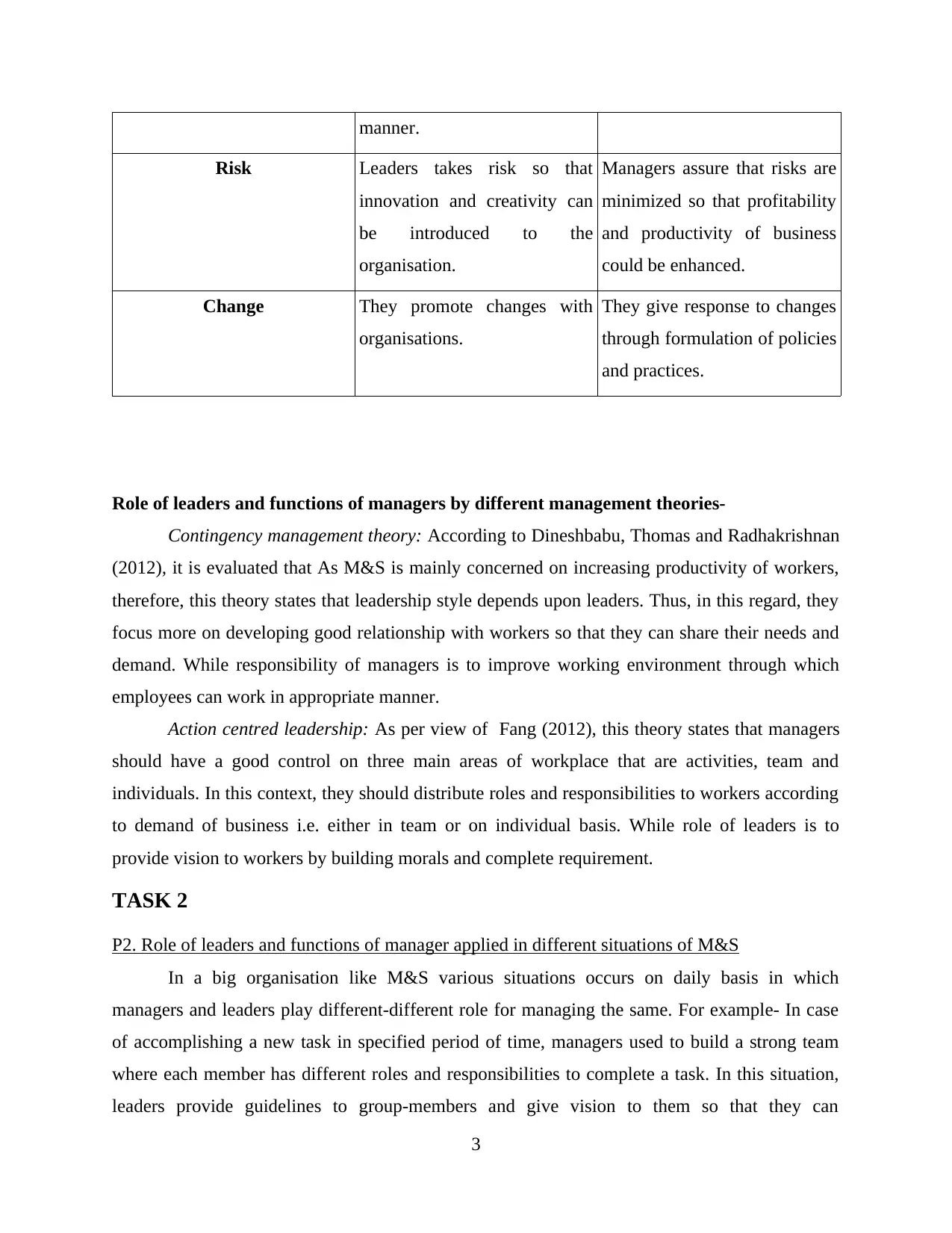
manner.
Risk Leaders takes risk so that
innovation and creativity can
be introduced to the
organisation.
Managers assure that risks are
minimized so that profitability
and productivity of business
could be enhanced.
Change They promote changes with
organisations.
They give response to changes
through formulation of policies
and practices.
Role of leaders and functions of managers by different management theories-
Contingency management theory: According to Dineshbabu, Thomas and Radhakrishnan
(2012), it is evaluated that As M&S is mainly concerned on increasing productivity of workers,
therefore, this theory states that leadership style depends upon leaders. Thus, in this regard, they
focus more on developing good relationship with workers so that they can share their needs and
demand. While responsibility of managers is to improve working environment through which
employees can work in appropriate manner.
Action centred leadership: As per view of Fang (2012), this theory states that managers
should have a good control on three main areas of workplace that are activities, team and
individuals. In this context, they should distribute roles and responsibilities to workers according
to demand of business i.e. either in team or on individual basis. While role of leaders is to
provide vision to workers by building morals and complete requirement.
TASK 2
P2. Role of leaders and functions of manager applied in different situations of M&S
In a big organisation like M&S various situations occurs on daily basis in which
managers and leaders play different-different role for managing the same. For example- In case
of accomplishing a new task in specified period of time, managers used to build a strong team
where each member has different roles and responsibilities to complete a task. In this situation,
leaders provide guidelines to group-members and give vision to them so that they can
3
Risk Leaders takes risk so that
innovation and creativity can
be introduced to the
organisation.
Managers assure that risks are
minimized so that profitability
and productivity of business
could be enhanced.
Change They promote changes with
organisations.
They give response to changes
through formulation of policies
and practices.
Role of leaders and functions of managers by different management theories-
Contingency management theory: According to Dineshbabu, Thomas and Radhakrishnan
(2012), it is evaluated that As M&S is mainly concerned on increasing productivity of workers,
therefore, this theory states that leadership style depends upon leaders. Thus, in this regard, they
focus more on developing good relationship with workers so that they can share their needs and
demand. While responsibility of managers is to improve working environment through which
employees can work in appropriate manner.
Action centred leadership: As per view of Fang (2012), this theory states that managers
should have a good control on three main areas of workplace that are activities, team and
individuals. In this context, they should distribute roles and responsibilities to workers according
to demand of business i.e. either in team or on individual basis. While role of leaders is to
provide vision to workers by building morals and complete requirement.
TASK 2
P2. Role of leaders and functions of manager applied in different situations of M&S
In a big organisation like M&S various situations occurs on daily basis in which
managers and leaders play different-different role for managing the same. For example- In case
of accomplishing a new task in specified period of time, managers used to build a strong team
where each member has different roles and responsibilities to complete a task. In this situation,
leaders provide guidelines to group-members and give vision to them so that they can
3
⊘ This is a preview!⊘
Do you want full access?
Subscribe today to unlock all pages.

Trusted by 1+ million students worldwide
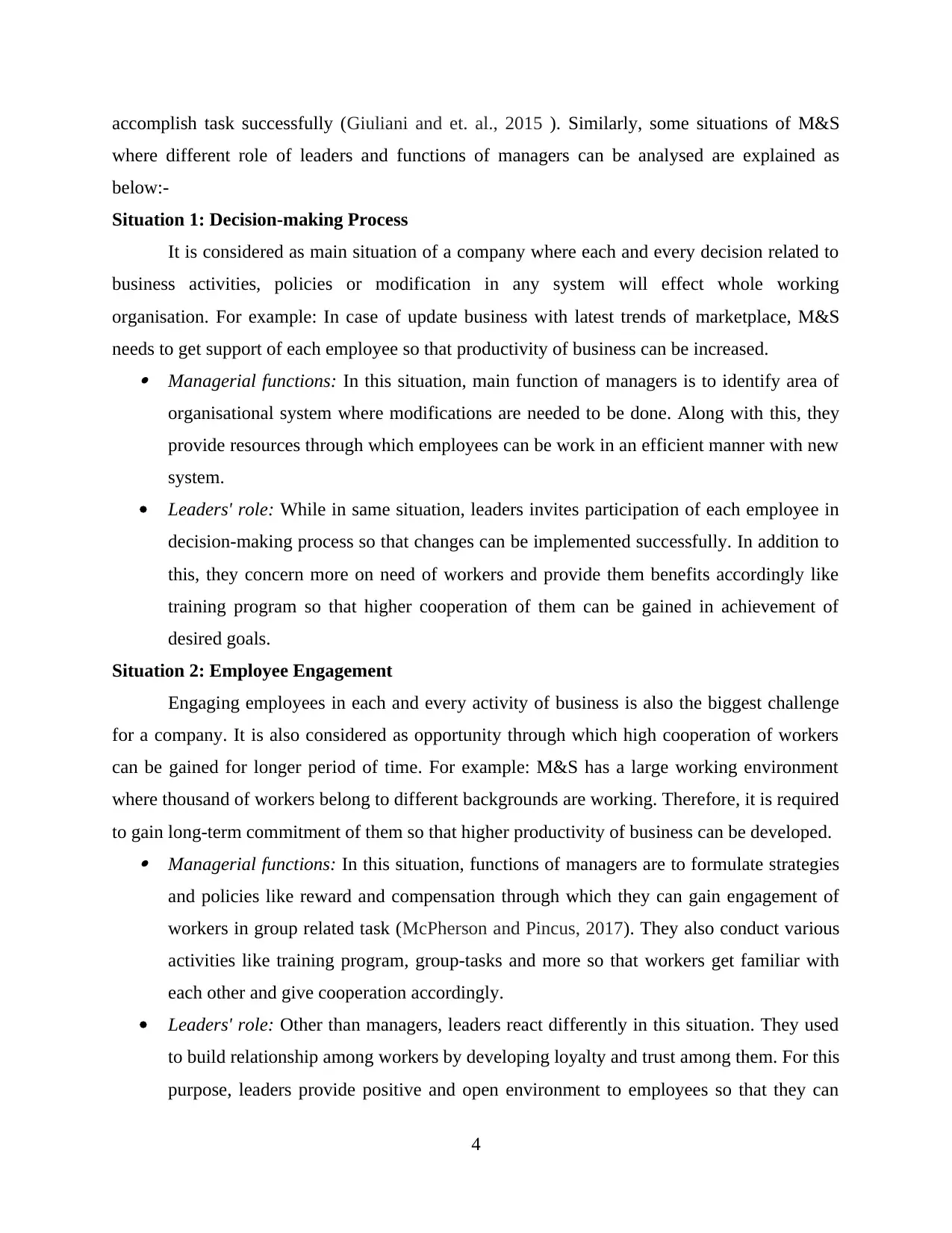
accomplish task successfully (Giuliani and et. al., 2015 ). Similarly, some situations of M&S
where different role of leaders and functions of managers can be analysed are explained as
below:-
Situation 1: Decision-making Process
It is considered as main situation of a company where each and every decision related to
business activities, policies or modification in any system will effect whole working
organisation. For example: In case of update business with latest trends of marketplace, M&S
needs to get support of each employee so that productivity of business can be increased. Managerial functions: In this situation, main function of managers is to identify area of
organisational system where modifications are needed to be done. Along with this, they
provide resources through which employees can be work in an efficient manner with new
system.
Leaders' role: While in same situation, leaders invites participation of each employee in
decision-making process so that changes can be implemented successfully. In addition to
this, they concern more on need of workers and provide them benefits accordingly like
training program so that higher cooperation of them can be gained in achievement of
desired goals.
Situation 2: Employee Engagement
Engaging employees in each and every activity of business is also the biggest challenge
for a company. It is also considered as opportunity through which high cooperation of workers
can be gained for longer period of time. For example: M&S has a large working environment
where thousand of workers belong to different backgrounds are working. Therefore, it is required
to gain long-term commitment of them so that higher productivity of business can be developed. Managerial functions: In this situation, functions of managers are to formulate strategies
and policies like reward and compensation through which they can gain engagement of
workers in group related task (McPherson and Pincus, 2017). They also conduct various
activities like training program, group-tasks and more so that workers get familiar with
each other and give cooperation accordingly.
Leaders' role: Other than managers, leaders react differently in this situation. They used
to build relationship among workers by developing loyalty and trust among them. For this
purpose, leaders provide positive and open environment to employees so that they can
4
where different role of leaders and functions of managers can be analysed are explained as
below:-
Situation 1: Decision-making Process
It is considered as main situation of a company where each and every decision related to
business activities, policies or modification in any system will effect whole working
organisation. For example: In case of update business with latest trends of marketplace, M&S
needs to get support of each employee so that productivity of business can be increased. Managerial functions: In this situation, main function of managers is to identify area of
organisational system where modifications are needed to be done. Along with this, they
provide resources through which employees can be work in an efficient manner with new
system.
Leaders' role: While in same situation, leaders invites participation of each employee in
decision-making process so that changes can be implemented successfully. In addition to
this, they concern more on need of workers and provide them benefits accordingly like
training program so that higher cooperation of them can be gained in achievement of
desired goals.
Situation 2: Employee Engagement
Engaging employees in each and every activity of business is also the biggest challenge
for a company. It is also considered as opportunity through which high cooperation of workers
can be gained for longer period of time. For example: M&S has a large working environment
where thousand of workers belong to different backgrounds are working. Therefore, it is required
to gain long-term commitment of them so that higher productivity of business can be developed. Managerial functions: In this situation, functions of managers are to formulate strategies
and policies like reward and compensation through which they can gain engagement of
workers in group related task (McPherson and Pincus, 2017). They also conduct various
activities like training program, group-tasks and more so that workers get familiar with
each other and give cooperation accordingly.
Leaders' role: Other than managers, leaders react differently in this situation. They used
to build relationship among workers by developing loyalty and trust among them. For this
purpose, leaders provide positive and open environment to employees so that they can
4
Paraphrase This Document
Need a fresh take? Get an instant paraphrase of this document with our AI Paraphraser
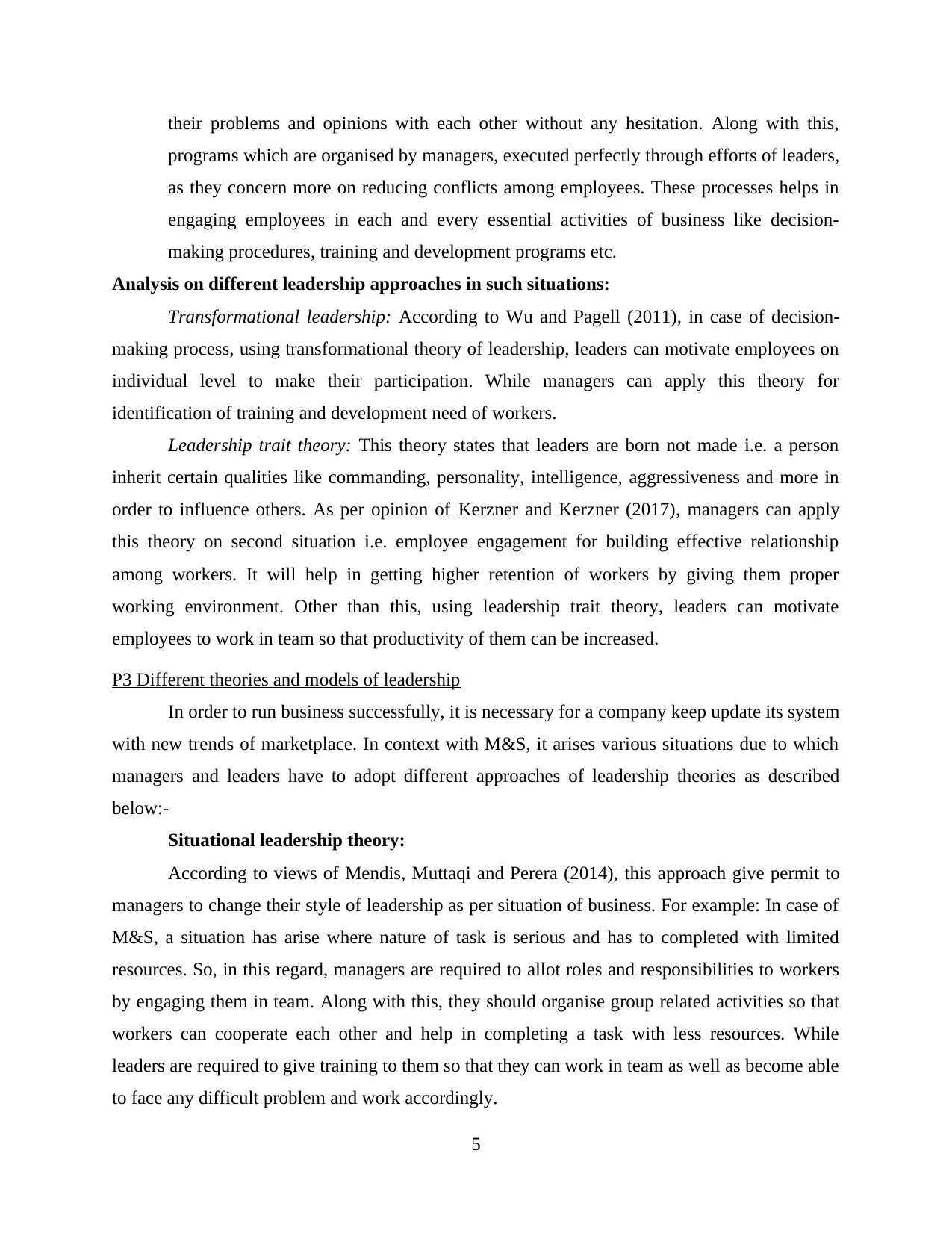
their problems and opinions with each other without any hesitation. Along with this,
programs which are organised by managers, executed perfectly through efforts of leaders,
as they concern more on reducing conflicts among employees. These processes helps in
engaging employees in each and every essential activities of business like decision-
making procedures, training and development programs etc.
Analysis on different leadership approaches in such situations:
Transformational leadership: According to Wu and Pagell (2011), in case of decision-
making process, using transformational theory of leadership, leaders can motivate employees on
individual level to make their participation. While managers can apply this theory for
identification of training and development need of workers.
Leadership trait theory: This theory states that leaders are born not made i.e. a person
inherit certain qualities like commanding, personality, intelligence, aggressiveness and more in
order to influence others. As per opinion of Kerzner and Kerzner (2017), managers can apply
this theory on second situation i.e. employee engagement for building effective relationship
among workers. It will help in getting higher retention of workers by giving them proper
working environment. Other than this, using leadership trait theory, leaders can motivate
employees to work in team so that productivity of them can be increased.
P3 Different theories and models of leadership
In order to run business successfully, it is necessary for a company keep update its system
with new trends of marketplace. In context with M&S, it arises various situations due to which
managers and leaders have to adopt different approaches of leadership theories as described
below:-
Situational leadership theory:
According to views of Mendis, Muttaqi and Perera (2014), this approach give permit to
managers to change their style of leadership as per situation of business. For example: In case of
M&S, a situation has arise where nature of task is serious and has to completed with limited
resources. So, in this regard, managers are required to allot roles and responsibilities to workers
by engaging them in team. Along with this, they should organise group related activities so that
workers can cooperate each other and help in completing a task with less resources. While
leaders are required to give training to them so that they can work in team as well as become able
to face any difficult problem and work accordingly.
5
programs which are organised by managers, executed perfectly through efforts of leaders,
as they concern more on reducing conflicts among employees. These processes helps in
engaging employees in each and every essential activities of business like decision-
making procedures, training and development programs etc.
Analysis on different leadership approaches in such situations:
Transformational leadership: According to Wu and Pagell (2011), in case of decision-
making process, using transformational theory of leadership, leaders can motivate employees on
individual level to make their participation. While managers can apply this theory for
identification of training and development need of workers.
Leadership trait theory: This theory states that leaders are born not made i.e. a person
inherit certain qualities like commanding, personality, intelligence, aggressiveness and more in
order to influence others. As per opinion of Kerzner and Kerzner (2017), managers can apply
this theory on second situation i.e. employee engagement for building effective relationship
among workers. It will help in getting higher retention of workers by giving them proper
working environment. Other than this, using leadership trait theory, leaders can motivate
employees to work in team so that productivity of them can be increased.
P3 Different theories and models of leadership
In order to run business successfully, it is necessary for a company keep update its system
with new trends of marketplace. In context with M&S, it arises various situations due to which
managers and leaders have to adopt different approaches of leadership theories as described
below:-
Situational leadership theory:
According to views of Mendis, Muttaqi and Perera (2014), this approach give permit to
managers to change their style of leadership as per situation of business. For example: In case of
M&S, a situation has arise where nature of task is serious and has to completed with limited
resources. So, in this regard, managers are required to allot roles and responsibilities to workers
by engaging them in team. Along with this, they should organise group related activities so that
workers can cooperate each other and help in completing a task with less resources. While
leaders are required to give training to them so that they can work in team as well as become able
to face any difficult problem and work accordingly.
5
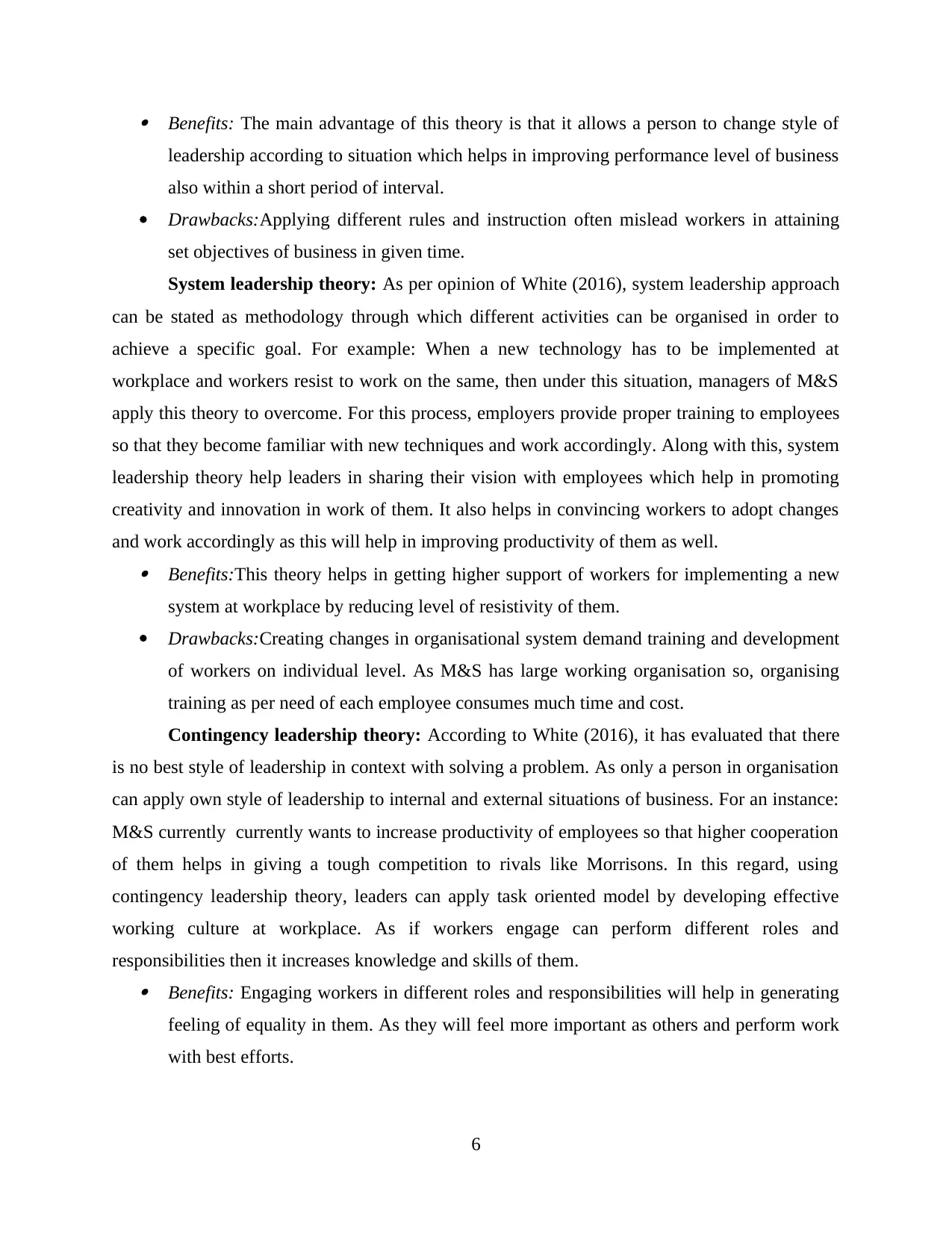
Benefits: The main advantage of this theory is that it allows a person to change style of
leadership according to situation which helps in improving performance level of business
also within a short period of interval.
Drawbacks:Applying different rules and instruction often mislead workers in attaining
set objectives of business in given time.
System leadership theory: As per opinion of White (2016), system leadership approach
can be stated as methodology through which different activities can be organised in order to
achieve a specific goal. For example: When a new technology has to be implemented at
workplace and workers resist to work on the same, then under this situation, managers of M&S
apply this theory to overcome. For this process, employers provide proper training to employees
so that they become familiar with new techniques and work accordingly. Along with this, system
leadership theory help leaders in sharing their vision with employees which help in promoting
creativity and innovation in work of them. It also helps in convincing workers to adopt changes
and work accordingly as this will help in improving productivity of them as well. Benefits:This theory helps in getting higher support of workers for implementing a new
system at workplace by reducing level of resistivity of them.
Drawbacks:Creating changes in organisational system demand training and development
of workers on individual level. As M&S has large working organisation so, organising
training as per need of each employee consumes much time and cost.
Contingency leadership theory: According to White (2016), it has evaluated that there
is no best style of leadership in context with solving a problem. As only a person in organisation
can apply own style of leadership to internal and external situations of business. For an instance:
M&S currently currently wants to increase productivity of employees so that higher cooperation
of them helps in giving a tough competition to rivals like Morrisons. In this regard, using
contingency leadership theory, leaders can apply task oriented model by developing effective
working culture at workplace. As if workers engage can perform different roles and
responsibilities then it increases knowledge and skills of them. Benefits: Engaging workers in different roles and responsibilities will help in generating
feeling of equality in them. As they will feel more important as others and perform work
with best efforts.
6
leadership according to situation which helps in improving performance level of business
also within a short period of interval.
Drawbacks:Applying different rules and instruction often mislead workers in attaining
set objectives of business in given time.
System leadership theory: As per opinion of White (2016), system leadership approach
can be stated as methodology through which different activities can be organised in order to
achieve a specific goal. For example: When a new technology has to be implemented at
workplace and workers resist to work on the same, then under this situation, managers of M&S
apply this theory to overcome. For this process, employers provide proper training to employees
so that they become familiar with new techniques and work accordingly. Along with this, system
leadership theory help leaders in sharing their vision with employees which help in promoting
creativity and innovation in work of them. It also helps in convincing workers to adopt changes
and work accordingly as this will help in improving productivity of them as well. Benefits:This theory helps in getting higher support of workers for implementing a new
system at workplace by reducing level of resistivity of them.
Drawbacks:Creating changes in organisational system demand training and development
of workers on individual level. As M&S has large working organisation so, organising
training as per need of each employee consumes much time and cost.
Contingency leadership theory: According to White (2016), it has evaluated that there
is no best style of leadership in context with solving a problem. As only a person in organisation
can apply own style of leadership to internal and external situations of business. For an instance:
M&S currently currently wants to increase productivity of employees so that higher cooperation
of them helps in giving a tough competition to rivals like Morrisons. In this regard, using
contingency leadership theory, leaders can apply task oriented model by developing effective
working culture at workplace. As if workers engage can perform different roles and
responsibilities then it increases knowledge and skills of them. Benefits: Engaging workers in different roles and responsibilities will help in generating
feeling of equality in them. As they will feel more important as others and perform work
with best efforts.
6
⊘ This is a preview!⊘
Do you want full access?
Subscribe today to unlock all pages.

Trusted by 1+ million students worldwide
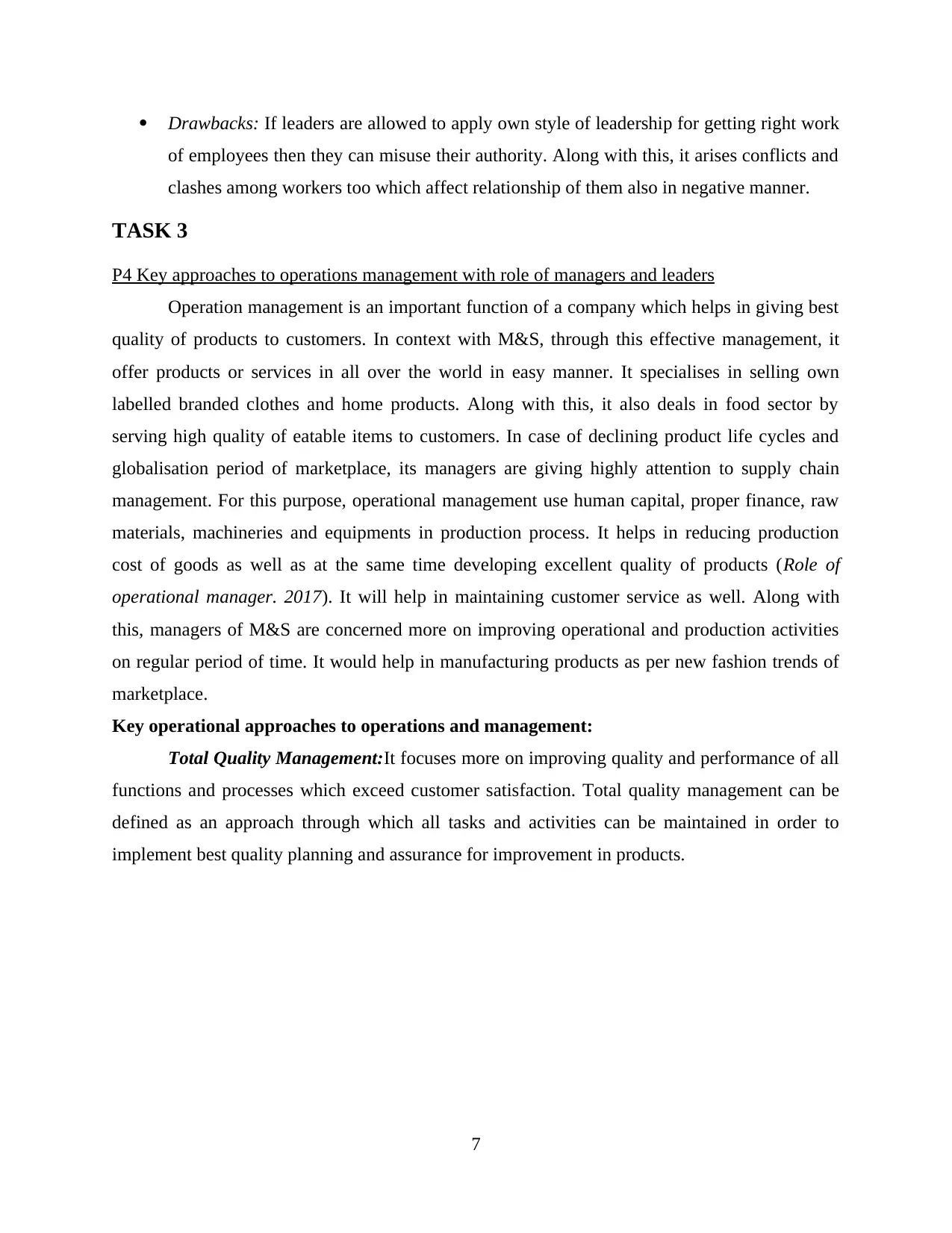
Drawbacks: If leaders are allowed to apply own style of leadership for getting right work
of employees then they can misuse their authority. Along with this, it arises conflicts and
clashes among workers too which affect relationship of them also in negative manner.
TASK 3
P4 Key approaches to operations management with role of managers and leaders
Operation management is an important function of a company which helps in giving best
quality of products to customers. In context with M&S, through this effective management, it
offer products or services in all over the world in easy manner. It specialises in selling own
labelled branded clothes and home products. Along with this, it also deals in food sector by
serving high quality of eatable items to customers. In case of declining product life cycles and
globalisation period of marketplace, its managers are giving highly attention to supply chain
management. For this purpose, operational management use human capital, proper finance, raw
materials, machineries and equipments in production process. It helps in reducing production
cost of goods as well as at the same time developing excellent quality of products (Role of
operational manager. 2017). It will help in maintaining customer service as well. Along with
this, managers of M&S are concerned more on improving operational and production activities
on regular period of time. It would help in manufacturing products as per new fashion trends of
marketplace.
Key operational approaches to operations and management:
Total Quality Management:It focuses more on improving quality and performance of all
functions and processes which exceed customer satisfaction. Total quality management can be
defined as an approach through which all tasks and activities can be maintained in order to
implement best quality planning and assurance for improvement in products.
7
of employees then they can misuse their authority. Along with this, it arises conflicts and
clashes among workers too which affect relationship of them also in negative manner.
TASK 3
P4 Key approaches to operations management with role of managers and leaders
Operation management is an important function of a company which helps in giving best
quality of products to customers. In context with M&S, through this effective management, it
offer products or services in all over the world in easy manner. It specialises in selling own
labelled branded clothes and home products. Along with this, it also deals in food sector by
serving high quality of eatable items to customers. In case of declining product life cycles and
globalisation period of marketplace, its managers are giving highly attention to supply chain
management. For this purpose, operational management use human capital, proper finance, raw
materials, machineries and equipments in production process. It helps in reducing production
cost of goods as well as at the same time developing excellent quality of products (Role of
operational manager. 2017). It will help in maintaining customer service as well. Along with
this, managers of M&S are concerned more on improving operational and production activities
on regular period of time. It would help in manufacturing products as per new fashion trends of
marketplace.
Key operational approaches to operations and management:
Total Quality Management:It focuses more on improving quality and performance of all
functions and processes which exceed customer satisfaction. Total quality management can be
defined as an approach through which all tasks and activities can be maintained in order to
implement best quality planning and assurance for improvement in products.
7
Paraphrase This Document
Need a fresh take? Get an instant paraphrase of this document with our AI Paraphraser
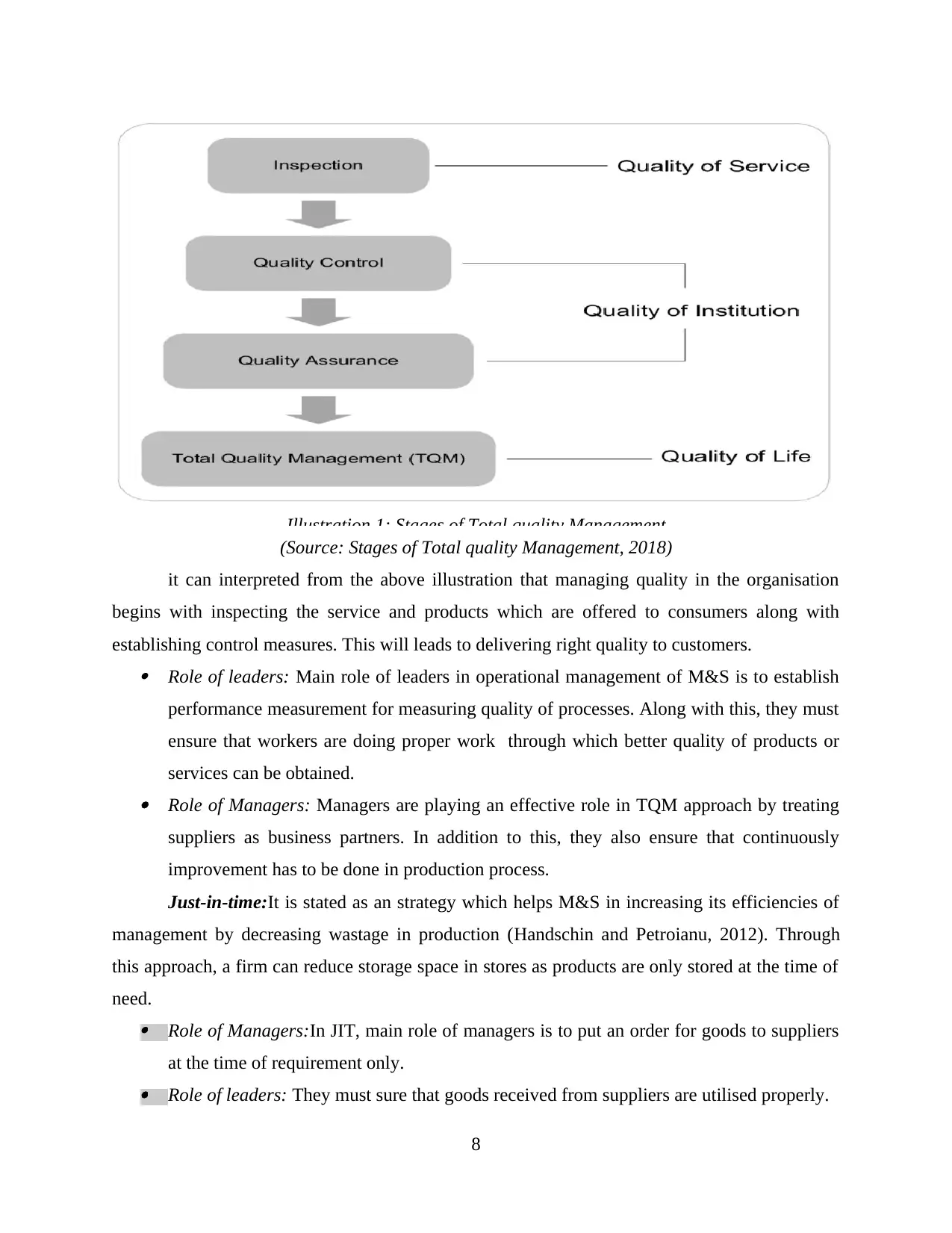
(Source: Stages of Total quality Management, 2018)
it can interpreted from the above illustration that managing quality in the organisation
begins with inspecting the service and products which are offered to consumers along with
establishing control measures. This will leads to delivering right quality to customers. Role of leaders: Main role of leaders in operational management of M&S is to establish
performance measurement for measuring quality of processes. Along with this, they must
ensure that workers are doing proper work through which better quality of products or
services can be obtained. Role of Managers: Managers are playing an effective role in TQM approach by treating
suppliers as business partners. In addition to this, they also ensure that continuously
improvement has to be done in production process.
Just-in-time:It is stated as an strategy which helps M&S in increasing its efficiencies of
management by decreasing wastage in production (Handschin and Petroianu, 2012). Through
this approach, a firm can reduce storage space in stores as products are only stored at the time of
need. Role of Managers:In JIT, main role of managers is to put an order for goods to suppliers
at the time of requirement only. Role of leaders: They must sure that goods received from suppliers are utilised properly.
8
Illustration 1: Stages of Total quality Management
it can interpreted from the above illustration that managing quality in the organisation
begins with inspecting the service and products which are offered to consumers along with
establishing control measures. This will leads to delivering right quality to customers. Role of leaders: Main role of leaders in operational management of M&S is to establish
performance measurement for measuring quality of processes. Along with this, they must
ensure that workers are doing proper work through which better quality of products or
services can be obtained. Role of Managers: Managers are playing an effective role in TQM approach by treating
suppliers as business partners. In addition to this, they also ensure that continuously
improvement has to be done in production process.
Just-in-time:It is stated as an strategy which helps M&S in increasing its efficiencies of
management by decreasing wastage in production (Handschin and Petroianu, 2012). Through
this approach, a firm can reduce storage space in stores as products are only stored at the time of
need. Role of Managers:In JIT, main role of managers is to put an order for goods to suppliers
at the time of requirement only. Role of leaders: They must sure that goods received from suppliers are utilised properly.
8
Illustration 1: Stages of Total quality Management
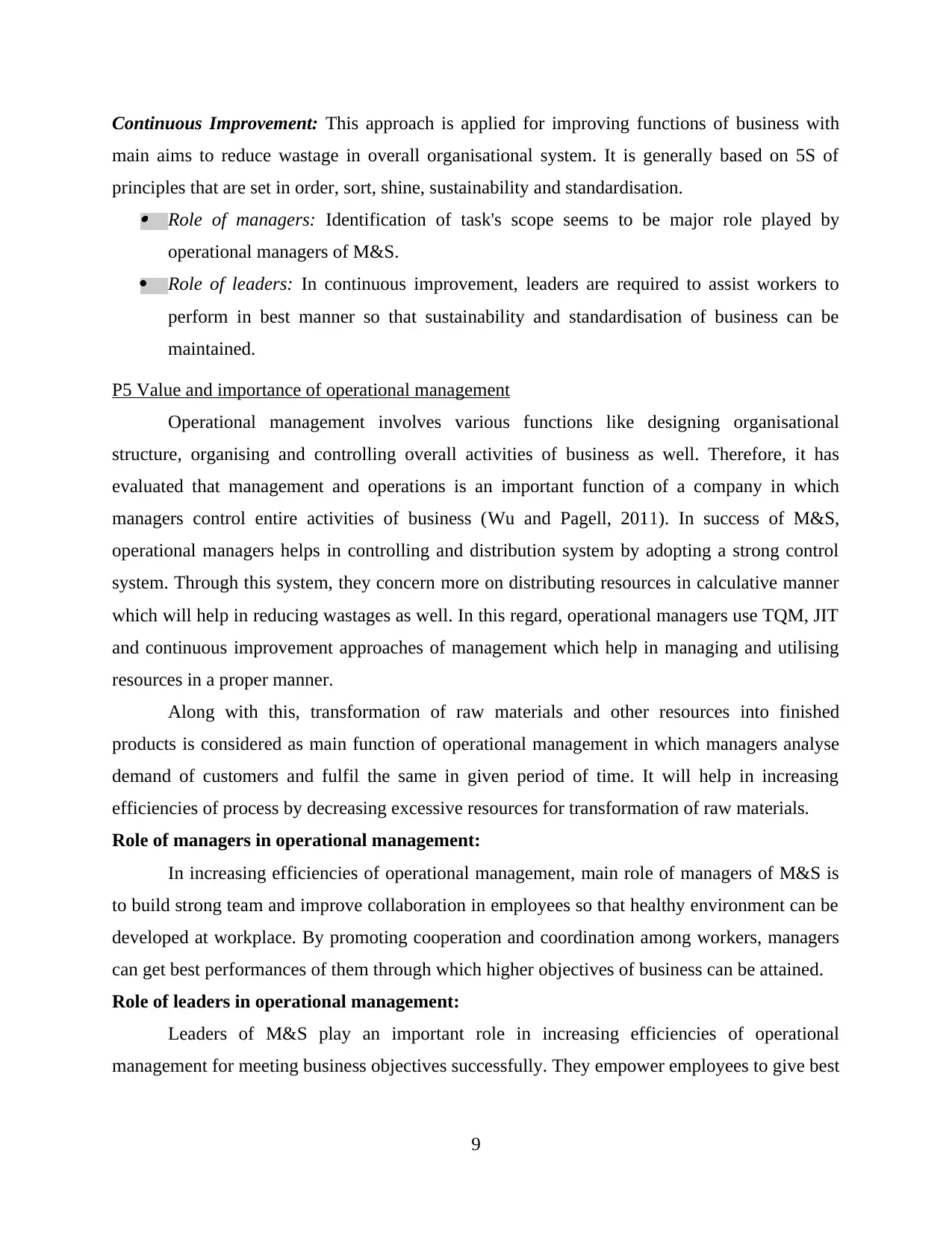
Continuous Improvement: This approach is applied for improving functions of business with
main aims to reduce wastage in overall organisational system. It is generally based on 5S of
principles that are set in order, sort, shine, sustainability and standardisation. Role of managers: Identification of task's scope seems to be major role played by
operational managers of M&S.
Role of leaders: In continuous improvement, leaders are required to assist workers to
perform in best manner so that sustainability and standardisation of business can be
maintained.
P5 Value and importance of operational management
Operational management involves various functions like designing organisational
structure, organising and controlling overall activities of business as well. Therefore, it has
evaluated that management and operations is an important function of a company in which
managers control entire activities of business (Wu and Pagell, 2011). In success of M&S,
operational managers helps in controlling and distribution system by adopting a strong control
system. Through this system, they concern more on distributing resources in calculative manner
which will help in reducing wastages as well. In this regard, operational managers use TQM, JIT
and continuous improvement approaches of management which help in managing and utilising
resources in a proper manner.
Along with this, transformation of raw materials and other resources into finished
products is considered as main function of operational management in which managers analyse
demand of customers and fulfil the same in given period of time. It will help in increasing
efficiencies of process by decreasing excessive resources for transformation of raw materials.
Role of managers in operational management:
In increasing efficiencies of operational management, main role of managers of M&S is
to build strong team and improve collaboration in employees so that healthy environment can be
developed at workplace. By promoting cooperation and coordination among workers, managers
can get best performances of them through which higher objectives of business can be attained.
Role of leaders in operational management:
Leaders of M&S play an important role in increasing efficiencies of operational
management for meeting business objectives successfully. They empower employees to give best
9
main aims to reduce wastage in overall organisational system. It is generally based on 5S of
principles that are set in order, sort, shine, sustainability and standardisation. Role of managers: Identification of task's scope seems to be major role played by
operational managers of M&S.
Role of leaders: In continuous improvement, leaders are required to assist workers to
perform in best manner so that sustainability and standardisation of business can be
maintained.
P5 Value and importance of operational management
Operational management involves various functions like designing organisational
structure, organising and controlling overall activities of business as well. Therefore, it has
evaluated that management and operations is an important function of a company in which
managers control entire activities of business (Wu and Pagell, 2011). In success of M&S,
operational managers helps in controlling and distribution system by adopting a strong control
system. Through this system, they concern more on distributing resources in calculative manner
which will help in reducing wastages as well. In this regard, operational managers use TQM, JIT
and continuous improvement approaches of management which help in managing and utilising
resources in a proper manner.
Along with this, transformation of raw materials and other resources into finished
products is considered as main function of operational management in which managers analyse
demand of customers and fulfil the same in given period of time. It will help in increasing
efficiencies of process by decreasing excessive resources for transformation of raw materials.
Role of managers in operational management:
In increasing efficiencies of operational management, main role of managers of M&S is
to build strong team and improve collaboration in employees so that healthy environment can be
developed at workplace. By promoting cooperation and coordination among workers, managers
can get best performances of them through which higher objectives of business can be attained.
Role of leaders in operational management:
Leaders of M&S play an important role in increasing efficiencies of operational
management for meeting business objectives successfully. They empower employees to give best
9
⊘ This is a preview!⊘
Do you want full access?
Subscribe today to unlock all pages.

Trusted by 1+ million students worldwide
1 out of 16
Related Documents
Your All-in-One AI-Powered Toolkit for Academic Success.
+13062052269
info@desklib.com
Available 24*7 on WhatsApp / Email
![[object Object]](/_next/static/media/star-bottom.7253800d.svg)
Unlock your academic potential
Copyright © 2020–2025 A2Z Services. All Rights Reserved. Developed and managed by ZUCOL.





